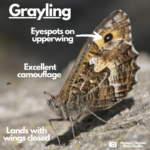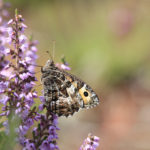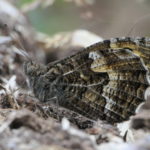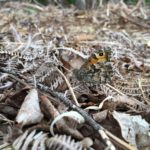Grayling

Back Grayling Silver-studded Blue Green Tiger Beetle Emperor Dragonfly Golden-ringed Dragonfly Black Darter
GRAYLING
Hipparchia semele
The Grayling is one of the UK’s largest brown butterflies and one of the best camouflaged. Their mottled brown under wings enable them to blend in with the background and they always rest with their wings closed. They have a black eye spot on each forewing and can be identified on the wing by their looping flight pattern.
- Grayling – Master of disguise!
- Grayling butterfly by Rob Solomon
- Grayling © Michael Jones
- Grayling butterfly © Steve Harley
- Camouflaged Grayling © Flo Cordner
[Click on the thumbnails to open]
Where/when to find them
Graylings can be found flying along dry, sandy heathland tracks from July to mid-September. They can also be found at coastal sites.
Being territorial in nature, males tend to be easier to spot, whether perching on a patch of bare ground, tree stump or boulder, flying up to meet any passing object in the hopes of finding a mate. However, their fantastic camouflage enables them to disappear right in front of your eyes!
Adaptations
Graylings have amazing camouflage. Their cryptically coloured underwings help to protect them from potential predators, enabling them to disappear when they land. You will often find Graylings flying up out of nowhere as you walk along the path.
Graylings can regulate their body temperature by orienting their body in relation to the sun. This tactic can also help in increasing camouflage by angling their wings to cast less of a shadow. They have eye spots on their wings which enable Graylings to surprise would-be predators.
Diet
Adult Graylings will take nectar from a range of sources, including Bell Heather and brambles.
Rarity
The Grayling is a Biodiversity Action Plan (BAP) priority species. Showing decreases in distribution and population since the mid-1970s.
Read more
Butterfly Conservation website: Grayling
#MoreThanJustNightjars





